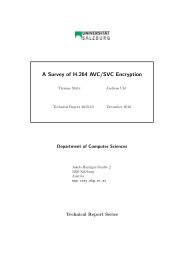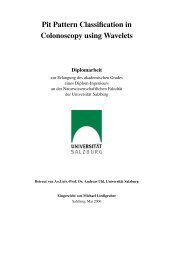Single-sensor hand and footprint-based multimodal biometric ...
Single-sensor hand and footprint-based multimodal biometric ...
Single-sensor hand and footprint-based multimodal biometric ...
Create successful ePaper yourself
Turn your PDF publications into a flip-book with our unique Google optimized e-Paper software.
2.4 State-of-the-art in H<strong>and</strong> <strong>biometric</strong>s<br />
Type Reference Description Samples FMR FNMR Indicator<br />
Geometry<br />
Geometry<br />
Palmprint<br />
Kumar et<br />
al. [18]<br />
Yoruk et al.<br />
[43]<br />
Kumar et<br />
al. [18]<br />
Palmprint Zhang [44]<br />
Palmprint Zhang [44]<br />
Fingerprint<br />
FVC2006<br />
DB2 open<br />
winner [50]<br />
4 finger lengths, 8 finger<br />
widths, palm width, palm<br />
length, <strong>h<strong>and</strong></strong> area, <strong>and</strong><br />
<strong>h<strong>and</strong></strong> length<br />
independent component<br />
features of the <strong>h<strong>and</strong></strong><br />
silhouette images<br />
st<strong>and</strong>ard deviation of greylevels<br />
in 144 overlapping<br />
blocks<br />
phase information of discrete<br />
Gabor Filter convoluted<br />
with palmprint subimage<br />
projection of 128 × 128<br />
sub-image onto eigenspace<br />
spanned by 100 eigenvectors<br />
(Eigenpalm approach)<br />
anonymous algorithm on<br />
400 × 560 (569 dpi) optical<br />
<strong>sensor</strong> data (BiometriKa)<br />
1000 5.29% 8.34% MinHTER<br />
458 2.77% 2.77% EER<br />
1000 4.49% 2.04% MinHTER<br />
425 0% 2.5% ZeroFMR<br />
3056 0.03% 1% FMR ≈ 0<br />
1680 0.02% 0.02% EER<br />
Table 2.2: Error rates of recent <strong>h<strong>and</strong></strong>-<strong>based</strong> <strong>biometric</strong> systems in verification mode.<br />
All <strong>h<strong>and</strong></strong>-<strong>based</strong> systems have the following major limitations in common: Firstly, most<br />
systems are overt, i.e. acquisition is an evident <strong>and</strong> cooperative process. Secondly, capture<br />
takes place with the subject nearby <strong>and</strong> often well-defined environmental conditions<br />
(such as e.g. lighting) are required. Finally, limitations concerning universality exist. The<br />
inability to acquire features may be caused by serious infringement (e.g. l<strong>and</strong> mines),<br />
congenital physical anomalies (e.g. polydactyly causing supernumerary fingers or dermatopathia<br />
pigmentosa, a disorder causing a lack of fingerprints), or even inappropriate<br />
hardware unable to deal with extreme shape.<br />
2.4.1 H<strong>and</strong> geometry<br />
H<strong>and</strong> geometry systems have been implemented since the early 1970s [13] <strong>and</strong> target the<br />
extraction of the silhouette shape of the human <strong>h<strong>and</strong></strong> or single fingers, finger lengths <strong>and</strong><br />
local widths. Measurements can easily be extracted from low quality scans or camera<br />
images of the <strong>h<strong>and</strong></strong> with resolutions starting at 45 dpi [43], as no textural information is<br />
involved. Shape-<strong>based</strong> features are invariant under environmental factors such as lighting<br />
conditions, sweat, dry skin or small injuries, however they may change over larger time<br />
spans, especially during growth [14]. Another difficulty is constituted by the physical<br />
anatomy of the human <strong>h<strong>and</strong></strong>. If fingers touch each other, salient points [28] needed for<br />
15








